Strategies for Turning Dissatisfied Customers Into Promoters
by Jonathan Seitz
Does this feel familiar? Is it possible that we have a customer who felt the same when they attempted to connect with us?
“It is not the employer who pays the wages. Employers only handle the money. It is the customer who pays our wages.” - Henry Ford
If we have a job or a business, we have customers (or clients*). Some of us connect directly with the customers that supply all of the money that our company receives (outside customers). Some of us work for departments that do not interact directly with external customers but keep reading, this is for you as well! We all have internal customers. Who relies on you to get their job done? This is your customer. You may not interact directly with the customer that pays the wages, but the service level to external customers is impacted by service to our INTERNAL customers.
What about YOUR boss – are they not your customer?
Personal note here: There are a lot of things I do well in business. There are several things that I do not do well … ONE of them is “managing up”. For years I took pride in the fact that I did not manage up. I was not counted among the “brown nosing” individuals that seemed to “kiss up” at every opportunity. Quite the contrary. I figured if this person was above me, I did not need to treat them as I would a client. After all, they were paid more, had a better title, and were supposed to be better at their job than I would be – otherwise, why were they there (and not me)? As you can imagine, this attitude did not serve me well. Don’t get me wrong, I have done well and my resume, career, and accomplishments are things I am proud of – but I could have done better if I had learned that my boss was my client early on – and treated them as such.
We are really talking here about dealing with dissatisfied customers – not how to get things right in the first place. That is for another topic. But what do we do when a customer is upset? ALL businesses have customers that are upset or frustrated at one time or another. The more customers we have, the more opportunity to not deliver to a customer’s expectations.
Make it Easy to Complain
The first issue we face is becoming aware of the dissatisfied customers that we have. How do we know when our customers are dissatisfied? This is an issue.
As a consumer, it seems to me that some companies don’t really WANT to hear from dissatisfied customers. I have had a terrible time getting help from some companies when I need it – or even finding out who to talk to – and then when I do, I am on hold and my anticipated wait time is 40 minutes.
In my younger days, if I was not satisfied with a product or service, I would mention the experience to a manager in order to help them know of a specific service breakdown. To my surprise this pointing out of a flaw in the delivery of their service was seldom welcomed with a “wow, I wish we had more customers like you, let me shake your hand and introduce you to our company president – I am sure they would like to meet you!”. More often than not, my mentioning it was as far as it would go and my attempt to help the company see a potential issue was less than welcomed. Furthermore, I was often left with the impression (once I was even told right out) that this is a common complaint and the person I told the issue to was helpless to do anything about it. I have changed – I seldom (if ever) voice my dissatisfaction (at least to the offending company). Now, when I have an issue with a product, I simply return it and don’t buy another. When I have a service issue, I stop using that service as fast as I can, or I do not go back to that restaurant, or cancel my subscription and find another provider. I am not a complainer – to the business – but my experience might just slip out during a conversation with my friends, or in a blog….
I find now I am in the majority of the population now- at least in this area.
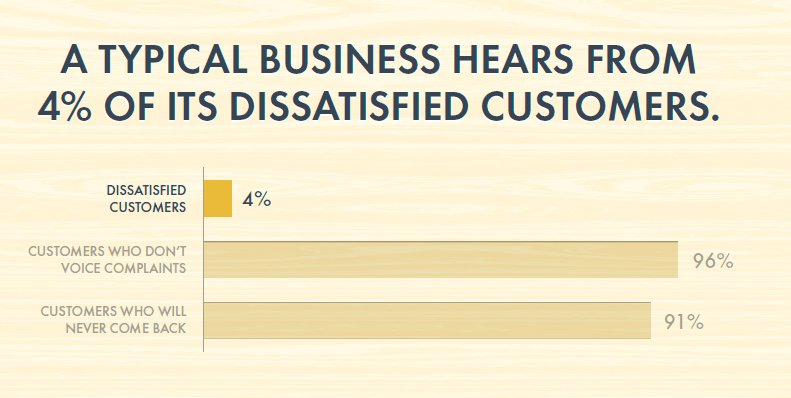
It turns out that studies show that only about 1 in 26 dissatisfied customers will voice their dissatisfaction to the company delivering the product or service. Has your company had a complaint this week? Statistically there are 25 other clients or customers that are dissatisfied but you don’t know about it and therefore have lost an opportunity so save them as a customer!
So what does this matter?
One customer complained and you were able to make them happy – possibly even turn them into a “promoter”. What do you think the other 25 are going to do about their pent up frustration? There is a well-known graphic that illustrates what would take me several paragraphs to discuss – The Customer Complaint Iceberg:
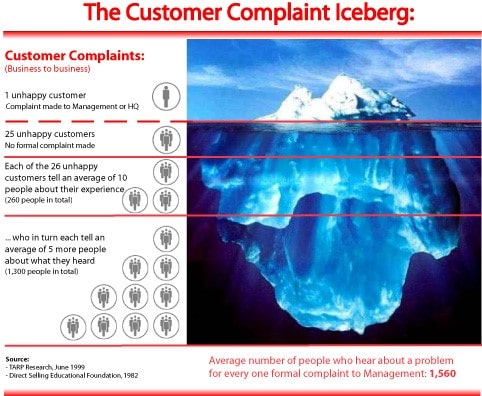
Based on the research (from 1982!), Hearing about a complaint from one customer may have meant that over 1,500 people have been given a negative impression about your company. So let’s update this to 2020.
“If you make customers unhappy in the physical world, they might tell six friends. If you make customers unhappy on the internet, they can each tell 6,000 friends.” – Jeff Bezos, Founder and CEO of Amazon
Today the number of people that may receive a negative impression about your business for each complaint you actually hear is not 1,560 individuals but rather more than 156,000 (a very conservative number). Do you think this is an exaggeration?
In July of 2014, Veronica Belmont and her husband Ryan Block called Comcast to disconnect their service. Posted on SoundCloud: "Overhearing the conversation, I knew this would not be very fun. What I did not know is how oppressive this conversation would be. Within just a few minutes the representative had gotten so condescending and unhelpful I felt compelled to record the speakerphone conversation on my other phone." He posted this ALONG WITH THE RECORDING OF THE CALL!!! (Listen to the call here: https://soundcloud.com/ryan-block-10/comcastic-service .) If you visit this on SoundCloud, you will notice that this recording has been listened to over 6,055,596 times! But wait! the Huffington Post picked up and wrote a brief article on this event (complete with sound recording) and from this secondary source, it has been shared on Facebook 5,857 times, tweeted 484 times, and shared on LinkedIn 143 times.
So what should we learn from this?
First, be thankful for the customers that do show their dissatisfaction. They are not only doing what you would otherwise pay for (market research) but they are also alerting you to other current clients you may be about to lose and not even know it. They are the canary in the mine! Be grateful for them, don’t ignore them.
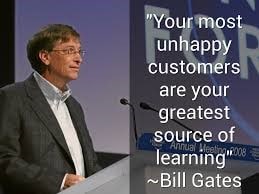
Second, each dissatisfied client that speaks up gives you an opportunity to create a “PROMOTER” – more on that further down the blog.
Third: “On average, corporations lose half their customers every 5 years.” - Frederick Reichheld, “The Loyalty Effect” Paying attention to the ones that show their dissatisfaction may alert you to a situation that may help seal the hole in the bucket.
Fourth, make it easy for customers to voice their dissatisfaction. Would it not be great if you were actually given the opportunity to turn the other 25 dissatisfied customers into promoters instead of quietly losing them as customers? Develop ways to get to know – take the temperature of your customers. I suggest reading Fred Reichheld’s book: “The Ultimate Question” for more on this (Am I beginning to sound like a Fred Reichheld Promoter?).
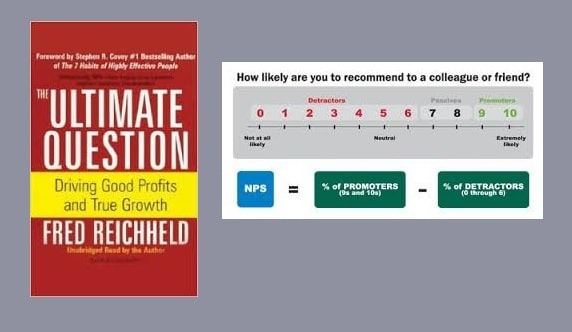
What is the POSITIVE Impact of dealing with dissatisfied customers?
Understand the LTV of your customer
The starting point is to understand what an individual customer/client contributes to your business. One way to quantify this is to understand the Lifetime Value of your Customer. (Since Frederick Reichheld covers this in his books, that you have just ordered or downloaded, there is no need to go into detail about it. It would spoil your reading enjoyment!)
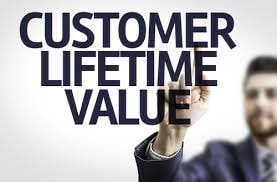
Suffice it to say, many companies go through the exercise to know this important detail. Once understood by everyone in the organization, every customer begins to take on a greater significance. For example:
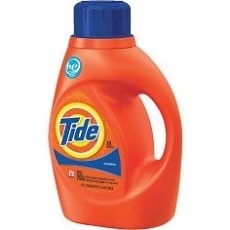
The lifetime value of a customer (LTV) for Tide Detergent is $8,500! I can buy a 50OZ container of Tide or $7.54.

The lifetime value of a customer for a Pizza Restaurant is $10,000! The national average for a slice of Pizza in the U.S. is $2.38. I see this as very important information to be understood by the 18 year old that is down to the last slice of pizza on the pie that has been sitting there for 2 hours when I order a slice and they hand me a cold slice with no cheese or sauce but is a fine example of how crust can create a bubble. It is NOT just a slice of PIZZA, it is a potential $10,000 worth of lifetime relocation!

The lifetime value of a customer for a Grocery store is $50,000!

The lifetime value of a customer for a Hotel is $100,000!

The lifetime value of a customer for a Luxury Car Manufacturer is $350,000!

The lifetime value of your Customer/Client is…
A good place to start to understand the value of a service recovery plan is to know the LTV of your customer and make sure everyone in the organization also knows what it is. Only then can you quantify the cost of a defecting customer or the value of keeping one.
Build Promoters
Beyond the Lifetime value of a Customer, the recovery of a dissatisfied customer can create a promoter! A promoter can generate relocation for your business that you cannot buy with marketing dollars. It has been said: “It’s not as important what you say about you as it is what others say about you!” We understand this and so we get testimonials. A Promoter is a walking testimonial for your product or service. Quite often, promoters are not created out of good service, they burst forth from an unexpected handling of an issue!
“Not every piece of negativity from a customer is bad news. Many times, it’s an opportunity to confound expectations, deliver something unexpected and completely turn that experience around.” - Andrew Gillespie, Four Seasons Hotels
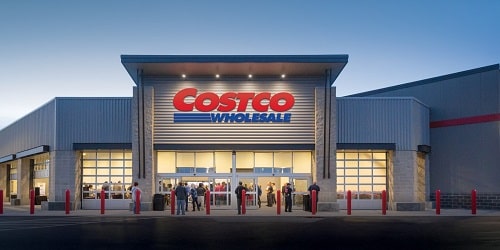
I am a PROMOTER of Costco. I once purchased a laptop for my daughter who took it to her first semester of college. With the help of several well-meaning friends, when she came home for Thanksgiving break, the Laptop was totally messed up (as they say in the military – it was FUBR). I went back to Costco – knowing that this was not their fault but maybe they could help me figure out what to do. I explained the situation to the service person – they looked at me (and maybe my purchase history at Costco) and said “wait right there”. When they came back they had in their hand a brand new laptop – the same model I was showing them that did not work – brand new and still in the box! They said “see if this one works a little better for you”. I am a Costco promoter! I don’t just keep quiet if someone is making negative comments about “Big Box Store”. I speak up! I tell them “I don’t know about other big box stores, but let me tell you about Costco…”
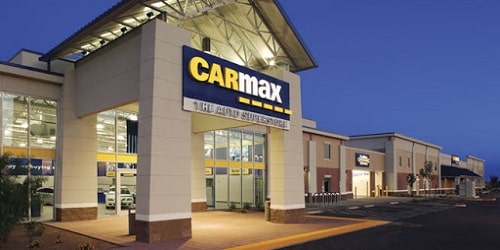
I hope I have another opportunity in another Blog to slip in why I am a promoter of Carmax…
But my story is nothing compared to the one told by Jon Picoult. Listen to his experience. He calls it the “Best Service Recovery Plan EVER”:
Fill the holes in the bucket
“On average, corporations lose half their customers every 5 years.” - Frederick Reichheld, “The Loyalty Effect”
If we did not lose customers, how much more business would we have five years from now than we would if we are average? Why do most customers leave? Better price? Better products? Better Marketing? NO.
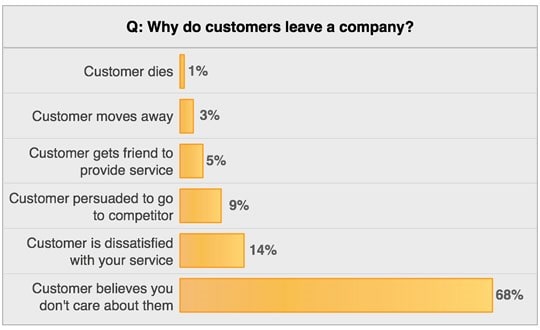
Nowhere do they feel this more acutely than when they have an issue and they are not satisfied with how the situation was handled, but more importantly, how they were dealt with.
In our Bullet Proof Manager Sessions in August, with the help Crestcom’s faculty member Jack Mackey, we learned skills and techniques for “Dealing with Dissatisfied Customers. (If you have not attended the Bullet Proof Manager Sessions yet… why not?)
“If we truly believe in the value of a loyal customer, in the lifetime value of repeated purchases, and the value of our good reputation, then it's our responsibility as leaders to have an effective plan to win back a customer's loyalty when problems occur.” - Jack Mackey
The reality is that most customer problems are predictable. If you have been in business for any length of time, you know the most common customer service issues. As a leader, it is important to take steps now to establish a Service Recovery Plan for the most common issues.
Some of the steps and key components of dealing with difficult customers Jack Mackey covered in the session included (these can be applied to external customers, internal customers, your boss, family, and friends!):
Treat the Person and then the Problem
- Listen Without interrupting – Most people want to be heard.
- “I apologize for the service breakdown”. Customers want an apology and this phrase gives them one without pointing blame
- Restate the complaint, including what happened and their feelings – this is a good interpersonal communication skill. “I know what I said but I am not sure you heard what I said until I hear you repeat it back to me.”
- “You shouldn’t have to put up with that” – don’t argue or defend…
Develop Solutions for predictable problems
- Train employees how to address predictable problems in the best possible ways. Have a best practice plan in place so there is a minimization of “creative guessing” about what the best course of action would be.
- Empower employees to do whatever it takes to solve the customer’s problems.
One company’s Customer Service Manual is essentially summed up with the phrase: “Use your own best judgement”. It may be a good idea to have some training on what is “good judgement” in your business. Give front line people a budget. How frustrated are you when you explain your issue to one person, they transfer you to another person so you again explain your issue to them. Then they can’t help because they don’t have authority to solve the issue so you are transferred again to the person that is empowered to help? Isn’t this Fun? Make the plan simple and empower front line people.

- Since we cannot predict every possible service breakdown, we cannot predetermine every solution. When we do not know how to solve the issue, most of the time we can simply ask: “I want to do what it takes to make this right, what do you think is a fair solution?”
- If the customer is mistaken about the facts, we could react and create a more combative situation. Instead we can disarm the situation with: “You might be right about that, let’s have a look”.
- For impossible to change complaints: Use the Feel – Felt – Found approach of relating the experience of others. For example: “I understand you feeling that our widgets are more expensive than our competitors. Initially, many people felt the same way. But after they have been using our widget for a while, they realise its greater reliability saves them both time and money in the long run”.
Over the past few weeks we have had a significant number of our Bullet Proof Manager Participants report how they have implemented or engaged these techniques and the corresponding significant financial impact. Only one saved client can make a big difference. Developing a promoter out of a dissatisfied customer can multiply your marketing efforts and your profits.
What is your Customer Service Recovery Plan?
*please note – I use the term customers throughout the blog but I have clients as do a lot of service industry leaders reading this blog. I am making no attempt to distinguish between an individual that pays for a product or one that pays for a service – for the most part in this context, it does not matter which you have.
